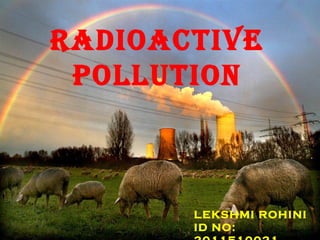Radioactive pollution can occur from various human activities involving radioactive materials and can have harmful effects. Some key sources are nuclear power generation, nuclear fuel processing, uranium mining, and nuclear weapons testing. Exposure to radiation can cause both acute and long-term health effects like cancer and genetic damage. In India, leakage from nuclear power plants has contaminated water sources and studies found high uranium levels in children living near coal power plants, linked to birth defects and disabilities. Preventing leakage and properly disposing of nuclear waste is important to control radioactive pollution.














































